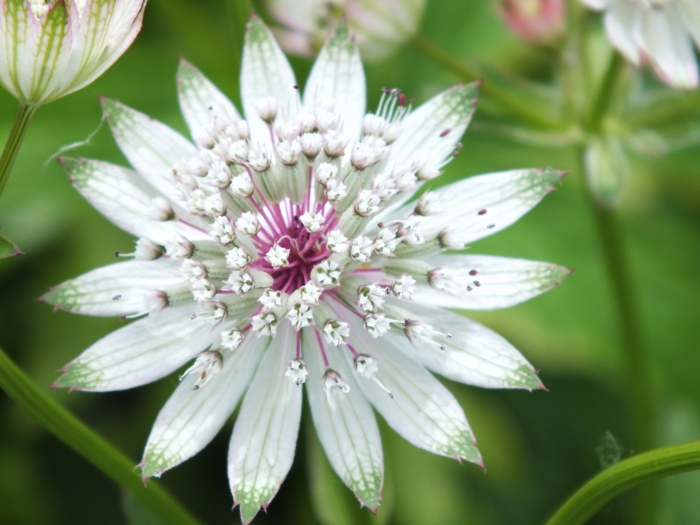Great Masterwort
(Astrantia major)
Great Masterwort (Astrantia major)
/
/

Nathan MacInnes
CC BY-SA 4.0
Image By:
Nathan MacInnes
Recorded By:
Copyright:
CC BY-SA 4.0
Copyright Notice:
Photo by: Nathan MacInnes | License Type: CC BY-SA 4.0 | License URL: https://creativecommons.org/licenses/by-sa/4.0 | Uploader: Macinn.es | Publisher: Wikimedia Commons | Title: Closeup_of_Astrantia_Major_flower.jpg | Notes: == Summary == I took this photo myself. I grow this Astrophytum ornatum in my nursery. == Licensing == {{PD-self}} Uploaded from the English Wikipedia by ~~~~ |



















































Estimated Native Range
Summary
Astrantia major, commonly known as Great Masterwort, is a deciduous perennial herb native to damp meadows, grasslands, and alpine areas of Europe and the Caucasus. It typically reaches around 60 centimeters (24 inches) in height, featuring an erect, glabrous stem with few branches and leaves. The plant is characterized by its compound umbels of tiny, star-shaped flowers surrounded by prominent bracts that are reddish or sometimes white, with an acuminate apex. The flowers, blooming from June to September, are greenish-white with reddish shades, with the central flowers being hermaphroditic and the outer ones male. Petals are white or slightly reddened, and the stamens are long and prominent, giving the flowers a distinctive appearance.
Great Masterwort is valued for its unique flowerheads that provide a long-lasting display of summer color in shades of red, pink, and white. It is often used in border plantings, cottage gardens, and as part of naturalistic landscaping. The plant thrives in part shade, requiring medium to high amounts of water and well-drained soil with good moisture retention. It is relatively low maintenance but benefits from deadheading to promote additional blooming. While generally disease-resistant, Astrantia major can suffer from powdery mildew in overly humid conditions. It is not known for aggressive roots or significant pest problems.CC BY-SA 4.0
Great Masterwort is valued for its unique flowerheads that provide a long-lasting display of summer color in shades of red, pink, and white. It is often used in border plantings, cottage gardens, and as part of naturalistic landscaping. The plant thrives in part shade, requiring medium to high amounts of water and well-drained soil with good moisture retention. It is relatively low maintenance but benefits from deadheading to promote additional blooming. While generally disease-resistant, Astrantia major can suffer from powdery mildew in overly humid conditions. It is not known for aggressive roots or significant pest problems.CC BY-SA 4.0
Plant Description
- Plant Type: Herb
- Height: 1.5-2.5 feet
- Width: 1-2 feet
- Growth Rate: Rapid
- Flower Color: Pink, Red, White
- Flowering Season: Spring, Summer, Fall
- Leaf Retention: Deciduous
Growth Requirements
- Sun: Part Shade
- Water: Medium, High
- Drainage: Medium
Common Uses
Bee Garden, Border Plant, Butterfly Garden, Deer Resistant, Groundcover, Low Maintenance, Potted Plant, Rock Garden, Salt Tolerant, Showy Flowers, Street Planting, Water Garden
Natural Habitat
native to damp meadows, grasslands, and alpine areas of Europe and the Caucasus
Other Names
Common Names: Astrantia , Greater Masterwort , Stor Stjerneskærm , Große Sterndolde , Große Sterndolde I.W.S. , Isotähtiputki , Grande Astrance , Liela Zvaigznite , Stjerneskjerm , Groot Sterrenscherm
Scientific Names: Astrantia major , Astrantia caucasica , Astrantia major var. maxima , Astrantia major var. minor , Astrantia montana , Astrantia vulgaris , Sanicula astrantia
GBIF Accepted Name: Astrantia major L.